Putting the energy transition in the hands of local citizens: the Bundorf PV farm
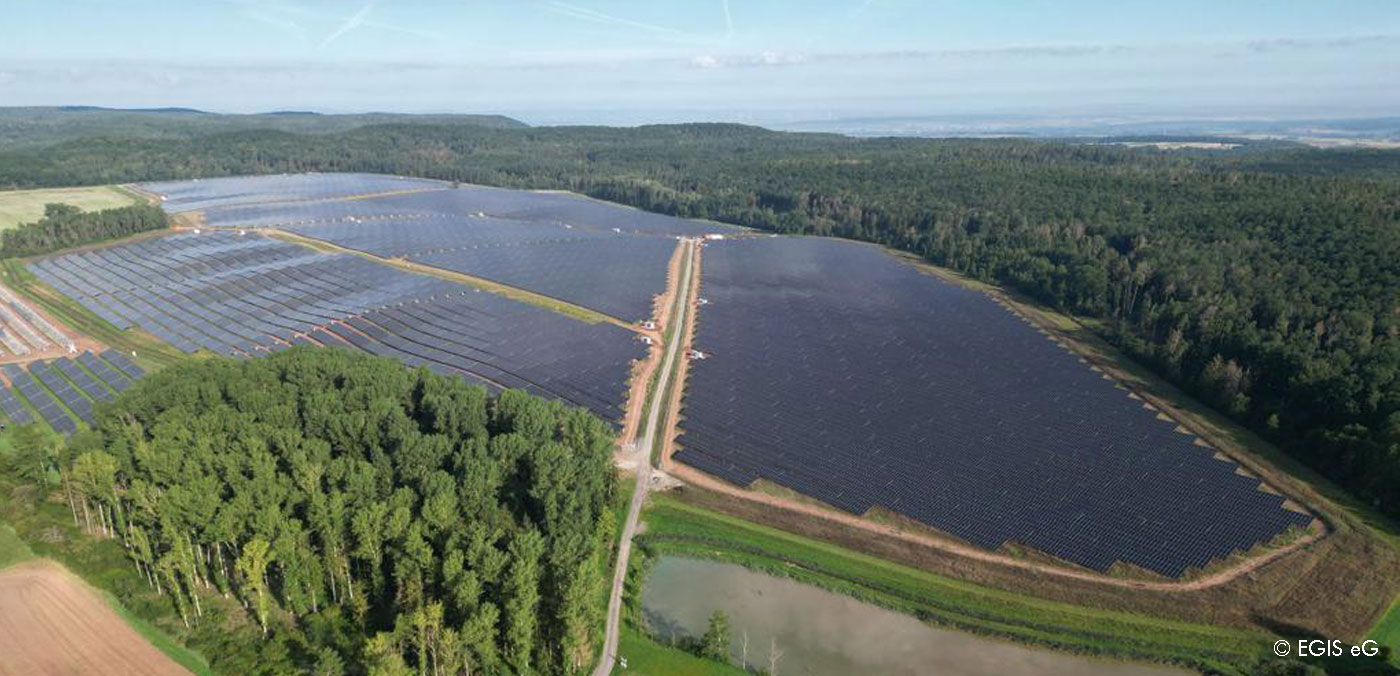
Right in the heart of Germany there is now a beacon of hope in the form of a PV farm showcasing how cities and local communities can transition to a renewable energy supply. But what makes this project in Bundorf so unique? The PV farm is one of the largest in Germany to involve public participation. Citizens can take part in the project through an energy co-operative and thus collectively drive forward the energy transition in their region. The PV farm generates not only solar power for personal use but also heat for local homes and companies as well as charging power for electric cars. There are lots of good reasons for a local energy transition.
With low precipitation and long periods of drought, Bundorf, a municipality in the district of Hassberge in the Lower Franconia region of Bavaria, Germany, is already feeling the direct effects of climate change and is one of the driest regions in Bavaria. This is making it increasingly difficult to exploit the arable land there for agricultural purposes.
In response, the local community pursued a whole new approach and, within just a short space of time, launched a flagship energy transition project. This was how, back in 2020, the idea of creating the largest ever citizens’ ground-based solar farm was born. The two-stage construction process – including an electrical substation – began on the 125-hectare site in October 2022. The facility was commissioned on September 28, 2023.
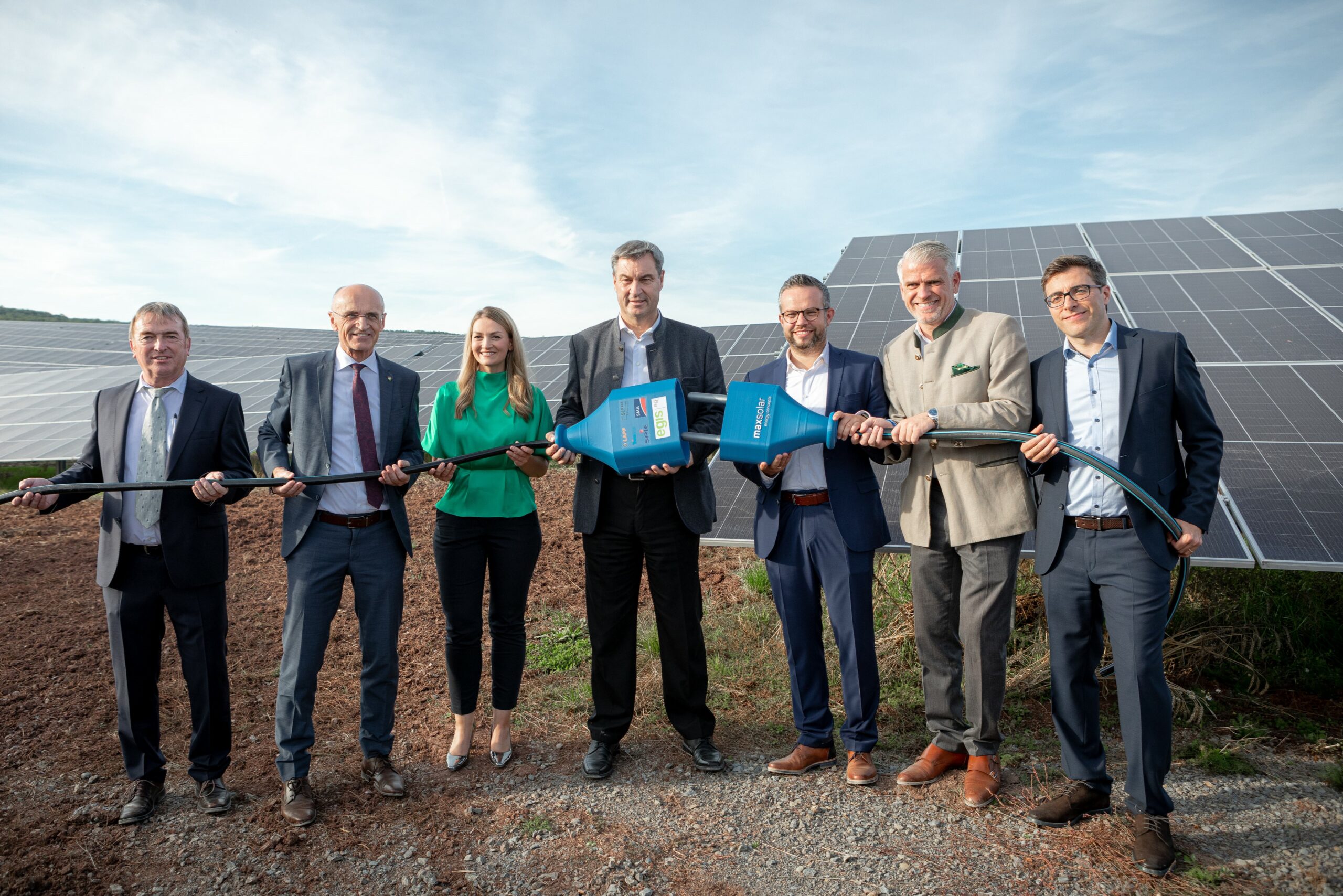
Ceremonial opening of the Bundorf PV farm on September 28, 2023. From left: Hubert Endres (mayor of Bundorf), Wilhelm Schneider (Hassberge district administrator), Judith Gerlach (Bavarian State Minister for Digital Affairs), Markus Söder (Minister-President of the People’s State of Bavaria), Christoph Strasser (CEO of Maxsolar), Steffen Vogel (member of the State Parliament for the district of Hassberge) and Pascal Lang (CEO of EGIS eG). Photo: Egis eG
With a total PV output of 125 megawatt-peak, however, the PV farm is so much more than merely a source of solar power; it is a flagship project demonstrating the concept of an integrated energy transition:
The PV farm was built by project partners MaxSolar and EGIS eG, an energy co-operative. With a share of 70 percent, project developer MaxSolar operates around two-thirds of the PV farm. Around one third of the farm is owned by the co-operative and serves as a citizens’ solar farm.
Right from the outset, everyone – the mayor, community representatives, project planners, operators, leaseholders and the population of Bundorf – worked toward a common goal, with the land being made available by different leaseholders. Less than two years passed between the initial project outline to the farm going online. All the necessary approvals were granted over the course of a year, and a sum amounting to €81 million was invested. The Inn-Salzach energy co-operative (EGIS eG) is contributing around €33 million to the 38-hectare citizens’ solar farm, including the heating network.
“A godsend for Bundorf.”
Hubert Endres, mayor
1. Integrated approach combines electricity, heat and mobility
The 125 MW PV farm generates around 131 million kilowatt-hours of electricity every year, theoretically enough to supply 37,500 households with power. But Bundorf, with a population of just 884, does not have anything like that number of households, which means that the nearby towns of Bad Königshofen, Hassfurt and Schweinfurt will also get to benefit from the solar power generated there.
The energy is fed into Bayernwerk’s grid. The grid operator also laid the AC cables and was responsible for building a series of medium-voltage transformer stations on the construction sites. These are routed to a central transmission station on the PV site. In addition, a feed-in substation was built at the feed-in point and a metering system involving the use of switch panels was developed for separate metering at the electrical substation. The energy feed-in level is 110 kV.
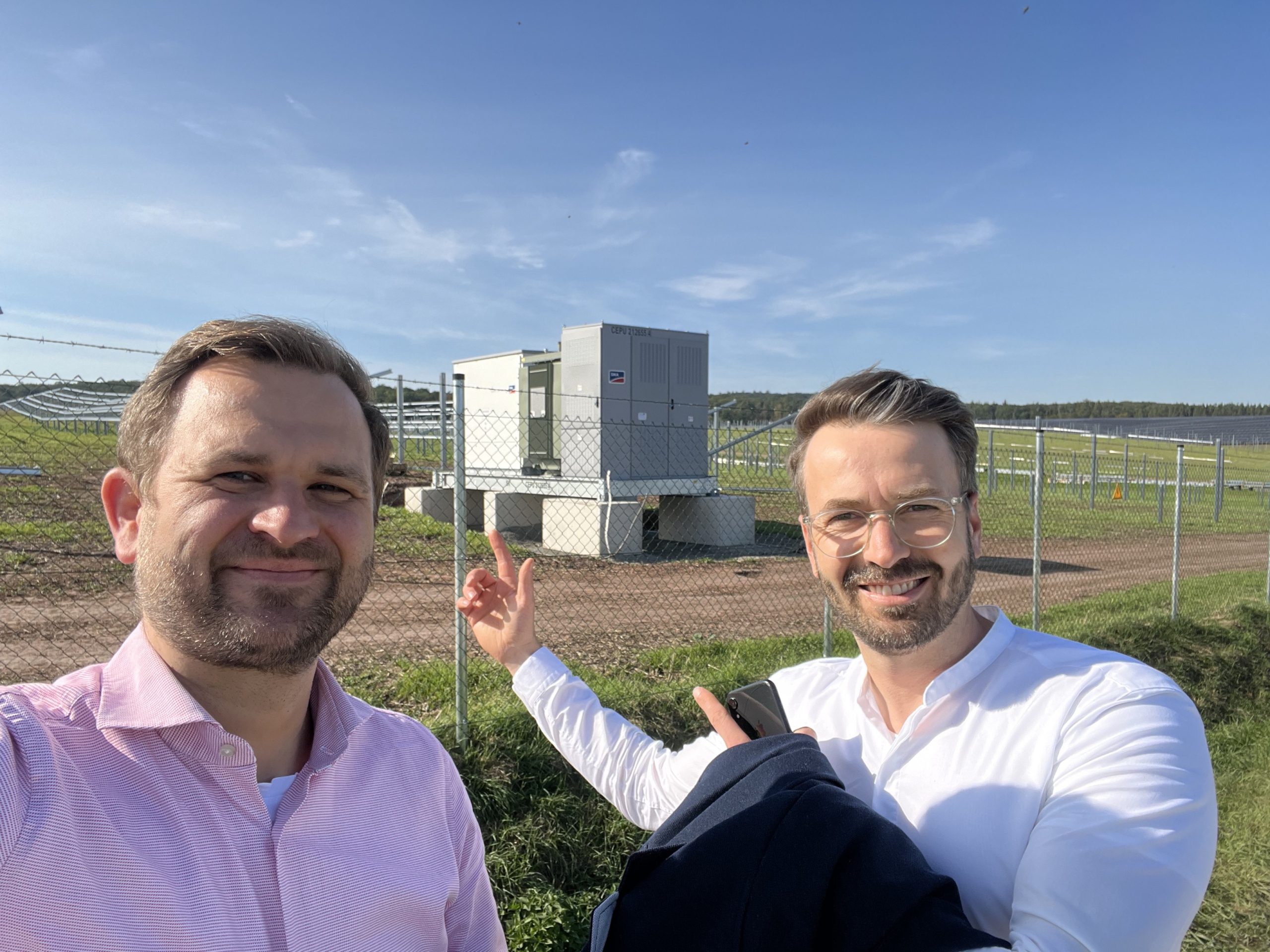
Michael Ebel, Head of Sales C&I, and Jan Goldau, Application Engineer Central Europe visiting on site: SMA’s Medium Voltage Power Stations have been delivered to the project in Bundorf as turnkey container solutions including a central inverter, transformer and switchgear.
1.1 PV power for heating buildings and fueling cars
In addition to the PV farm, a zero-emissions district heating network for supplying local homes and municipal properties is scheduled for completion by the end of the year. Via a district heating station (150 kW) in the home, heat is supplied from the water circulating in the pipeline network into the home as and when needed.
A large hot water tank (buffer tank) ensures that enough heat is available even in winter or whenever there is little sunlight. In winter, a woodchip boiler with 200 kilowatts serves as a redundancy, covering peak load and low-sun winter periods for a maximum of 1,600 hours. Municipal properties such as the community center and kindergarten in Bundorf are also to be supplied with green district heat.
As general contractor, MaxSolar is responsible for planning, implementation as well as maintenance and servicing. The district heating network operator is EGIS eG.
Bundorf is also being armed for a new era of mobility. The charging infrastructure for electric vehicles is also being expanded in and around Bundorf, simultaneously with the other construction work taking place. Twelve charging terminals will then supply electric vehicles with green energy generated at the PV farm.2. Greenery to prevent surface sealing
Ground-based solar farms are often criticized because of the perception that they contribute to the issue of surface sealing. In reality, however, the opposite often holds true. In Bundorf, the land where the PV farm is situated is used for compensation purposes to enrich the otherwise low-yield soil.
The PV modules provide shade for flora and fauna and prevent the soil from drying out during long periods of low rainfall.
Opening up the land to natural grazing by sheep, for example, helps the soil to recover from overfarming.
Some of the area has been repurposed as dry meadowland to support nature conservation and preserve biodiversity. Native seeds help to create valuable habitats for local plants and numerous animal species.
A low-lying fence ensures that small wild animals can pass through the solar farm. Bigger animals can reach the neighboring woodland via a special corridor. Thanks to all these measures, the PV farm is actually helping to preserve natural habitats and promote local biodiversity. And the first signs of success can already be seen, as the number of skylarks – which enjoy special protection in Germany – setting up home within the area covered by the PV farm recently increased dramatically. The favored habitat of these small, ground-nesting songbirds is open land. And they clearly feel right at home here in Bundorf, as anyone living nearby can hear. From January to the end of July, they can be heard singing and chirping away among the PV modules long into the evening.
Tip: To ensure that ground-based PV systems are sensitively incorporated into the surrounding countryside, planners can also refer to the “Good Planning” checklist created by the Association of Energy Market Innovators (bne). In this way, the association is supporting the positive contribution made by ground-based PV systems not only to climate protection, wildlife conservation and nature conservation but also to rural development. MaxSolar was one of the first companies to sign up to this voluntary commitment.
3. Free marketing of the electricity and public participation
One section of the ground-based PV system is operated by MaxSolar, an independent power producer (IPP), who sells electricity via a power purchase agreement (PPA). This form of selling renewable energy is becoming increasingly widespread here in Germany. A PPA is a type of electricity supply contract that is signed directly with the customer over a fixed period.
3.1 Public participation
The citizens’ solar farm and district heating network are operated by EGIS eG, which aims to offer the people of Bundorf their own electricity and charging tariffs. Local citizens, municipalities, associations, foundations and companies can also participate through the purchase of cooperative shares. One cooperative share is worth €150, plus a €5 surcharge. The purchase of cooperative shares is currently limited to 4,300 shares per member, which equates to a sum of €645,000.
However, participation in the energy co-operative is not tied to the PV project in Bundorf but applies to energy transition projects throughout Germany. Members receive annual dividends on their shares.
4. A flagship project delivering added value for communities
The Bundorf PV farm is a great example of how the energy transition can embrace local citizens and be implemented in harmony with nature. It highlights the added value that energy transition projects like this can bring to economically underdeveloped regions, which can benefit from local value creation and thus become more attractive. We urgently need more initiatives like this in order to promote not only climate protection, biodiversity, environmental protection and nature conservation but also rural development.
Interested in learning more about the Bundorf project?
Interview with Pascal Lang, CEO of EGIS eG

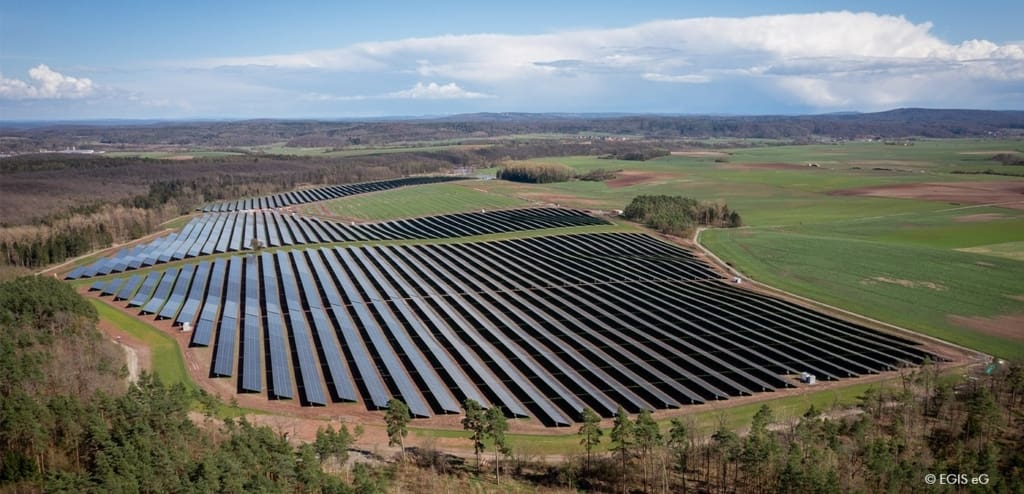
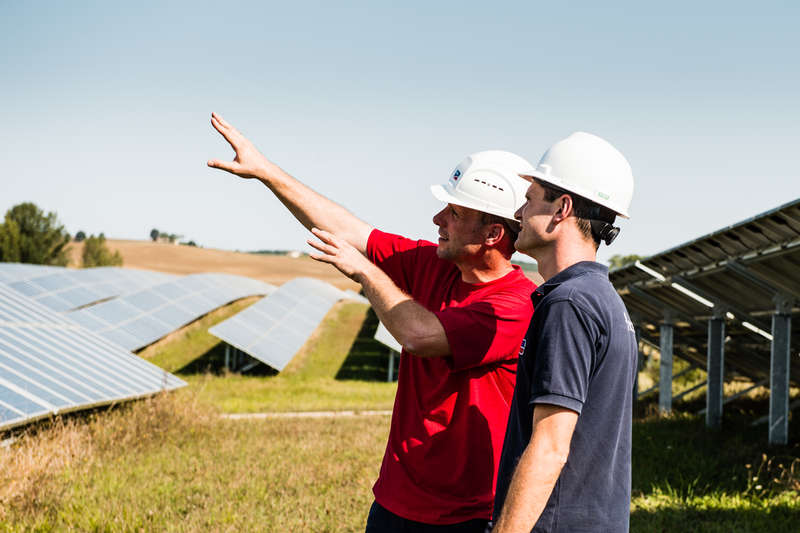
Feel free to contribute!